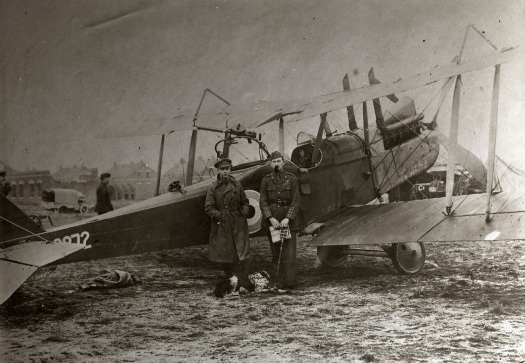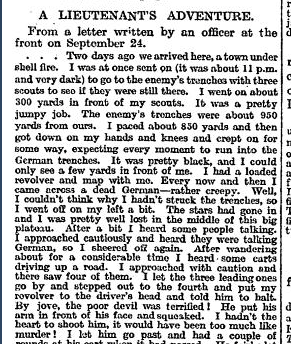In a day that came close to ending in disaster, Greg and Capt. Gordon were down to do a shoot – the last time in the war that Greg was down to do one. But it was unsuccessful, presumably because of poor weather. In a subsequent adventure behind enemy lines, a rifle shot from a German soldier at an occupied chateau nearly did for both of them. Unsurprisingly, they found that strafing an occupied chateau is dangerous.
Log Book

![]()
Date: 2.11.18 Time Out: 13.00 Rounds Fired – Lewis: 400 Rounds Fired – Vickers: 100 Bombs: 4 Time on RE8s: 187 hrs 5 mins RE8: 2517 Observer: Cpt. Gordon War Flying: 1 hrs 55 mins Height: 3500 Course/Remarks: Shoot 6” How (99). Unsucc. Pet. tank shot.
Unsuccessful Shoot
We have no further details of the shoot, other than it was with 99 Siege Battery RGA, who were firing 6-inch howitzers, and that it was unsuccessful. (Greg had shot with 99 Siege Battery previously, on 22 August 1918 and 24 August 1918.) The intended target must have been something east of the River Scheldt/Escaut, as that was where the British front line was only yesterday. Given what we know from the rest of the day’s event, it seems likely that it was the weather that washed out the shoot.
Petrol Tank Shot
The laconic, three last words of the log book entry cover are a very sparse indication of what Greg and Capt. Gordon got up to next. It became something of a Gregory family story. It’s worth bearing in mind that Capt. Gordon was not only Greg’s observer this day, but was also his senior officer.
Rob Parsons, Greg’s son-in-law and my stepfather, recalls Greg recounting the events of that murky afternoon like this:
Gordon had decided that flying conditions were still good enough to go and annoy the Hun, even if it was only a spot of defenestration. So off they went, with a very reluctant pilot, in search of a little sport. Just as Greg was hoping he could say the fuel state meant they must turn for home, out of the murk appeared the perfect target in the form of a German-occupied Chateau. So he obediently descended to the level of the upper floor, through the windows of which Gordon emptied the drum of his Lewis gun. Meanwhile, as Greg climbed away and turned for home, Gordon had changed the drum and ordered him to go back because he “hadn’t done downstairs!”
It was during this second pass that, not surprisingly, the Huns started to shoot back. As he began to climb away, Greg recalled seeing a German on one knee, in classic toy soldier pose with rifle, shooting at him from the corner of the Chateau. That’s when a shot punctured the fuel tank and he began to be drenched with fuel. Fortunately, the aircraft didn’t catch fire. Anyway, he instinctively opened the throttle as far as it would go and began to climb as hard as he could. There the throttle stayed until he ran out of fuel.
Until then of course, he was being sprayed with fuel and he said he was close to getting frostbite. The fact that he returned safely is proof that he gained enough height to cross the enemy lines without being potted at by otherwise unoccupied Huns in the trenches. They made it back, and the aircraft was back in service the next day.
So, eight days before the war was over, it nearly ended very badly.
Sidelights
The log book and family recollection are all we have to go on for these events (oh that the Squadron Record Book were available!) Nonetheless, there are a few interesting sidelights that illuminate what went on.
Rounds Fired
First, note the number of rounds fired, as recorded in the log book. 100 rounds were fired from the Vickers gun, which was pilot-operated and forward facing. And Capt. Gordon fired 400 rounds from the Scarff ring-mounted Lewis gun in the rear compartment. Greg never recorded more rounds fired in from the Lewis gun a single patrol. This was certainly consistent with a major shoot up, at least in small arms terms.
The Petrol Tank
Secondly, consider the position of the petrol tank. The tank was an elliptical-sectioned cylinder running fore-and-aft, and mounted immediately behind the dashboard. In this photo of the front cockpit of replica RE8 A3930 at the RAF Museum, London, the pale grey bottom of the tank is just visible below the bottom lip of the dashboard. And the fuel filler cap is further forward on the top.

The position of the tank can also be seen in the top left drawing from The Vintage Aviator Limited’s RE8 Gallery collection here.
So the tank was essentially above the pilot’s legs. It was therefore no surprise that petrol from the punctured tank drenched Greg with fuel. He was extraordinarily lucky that a fire didn’t break out. He was also lucky that the bullet didn’t hit him.
An Extraordinarily Safe Job?
Thirdly, it may not be accidental that Capt. Gordon did not apparently write to his mother about the events of today. One wonders whether he recalled that only yesterday he had written to her:
This is an extraordinary safe job & no one gets hurt at it. So don’t you worry, dear old bird.
Given that he had himself been hit in the (wooden) leg on an earlier flight, and only one week ago today Greg’s propeller had been split by shrapnel, it is clear that a good deal of luck was involved in ‘not getting hurt’ – or worse. Today’s events underlined that. But no doubt Capt. Gordon was writing more to reassure his mother than to be candid.
A Mere Bagatelle
Where was the chateau that they shot up? The log book doesn’t record it; Greg was no longer writing his diary; and of course we don’t have the SRB entry for the day. However, with a bit of deduction and a liberal amount of conjecture, it may have been the deliciously named Château Bagatelle at Wattripont on the road running northeast from Tournai towards Renaix (Ronse).
The evidence is this. Wattripont is a plausible distance from Ascq – 19 miles (30.5 km). It’s about the same distance beyond the British front line as the line was from Ascq. And it’s in a plausible location, in fact almost familiar territory. Greg’s recent reconnaissance and counter-battery patrols had been reporting on locations north and northeast of Tournai. Only two days ago on 31 October 1918, he had reported fires and explosions in DB zone. Wattripont is in EB zone, 6,000 yards to the east, as can be seen on this map:

And Wattripont has a good candidate chateau with two floors: the now comfortable looking Château Bagatelle:

So just maybe this was the chateau in question.
Another Near Disaster
Today’s near disaster was just days before the armistice. It bookends another near disaster five months ago, when Greg crashed on his first day on the Western Front on 4 June 1918. Though that time he couldn’t blame the enemy.
Tuesday 4 June 1918 – Near Disaster on the First Day on the Front




































 Ascq, where 42 Squadron was moving to, was a small settlement a couple of miles out into the countryside east of Lille, with a station on the railway line to Tournai. Today, it still has the station, but it has grown into Villeneuve-d’Ascq, which is practically a city in its own right. Villeneuve-d’Ascq is home to the Université de Lille, Campus Cité Scientifique, and to the headquarters of the well known French supermarket Auchan.
Ascq, where 42 Squadron was moving to, was a small settlement a couple of miles out into the countryside east of Lille, with a station on the railway line to Tournai. Today, it still has the station, but it has grown into Villeneuve-d’Ascq, which is practically a city in its own right. Villeneuve-d’Ascq is home to the Université de Lille, Campus Cité Scientifique, and to the headquarters of the well known French supermarket Auchan. 


